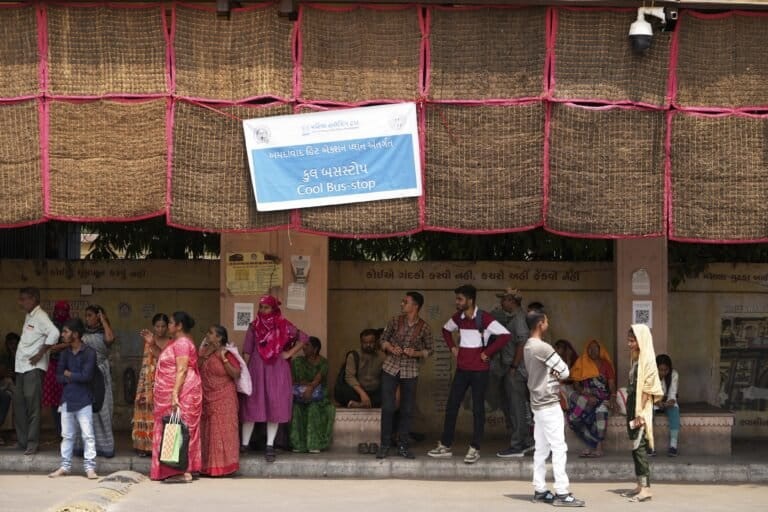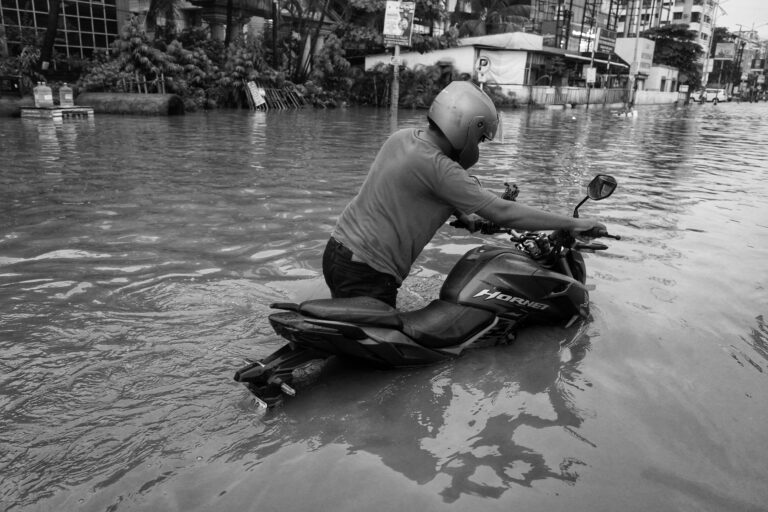- Food delivery workers, riding on two-wheelers, are breathing in highly polluted air, finds a study conducted in Ghaziabad.
- Delivery workers in Ghaziabad are exposed to particulate matter and volatile organic compounds at much higher levels than standards set by India’s Central Pollution Control Board and the World Health Organisation.
- The study also found that about 67% of the workers surveyed had no awareness of the adverse impact of pollution on their health.
- Experts urge for improvement of working conditions such as better company policies, provision of protective equipment and regular health check-ups and health insurance.
Rohit Vishwas, 28, started working as a delivery person for a grocery delivery app in 2021 after he lost his marketing executive job during the Covid-19 pandemic. He spent eight to ten hours on the road every day. Though he now works for a bike taxi app, his job is still strenuous; he spends two hours every day waiting in traffic jams, transporting customers in south Delhi. “I get headaches when I work too hard,” he told Mongabay-India.
Like Vishwas, there are 7.7 million gig workers in India in 2020-21, projected to rise to 23.5 million workers over the next ten years, by 2029-30.
A recent study reveals that the air that food delivery workers breathe, while riding their two-wheelers, is filled with high concentrations of particulate matter (PM) and volatile organic compounds (VOC) such as benzene, a carcinogen.

“The most alarming part is their exposure to the level of particulate matter and their [lack of] risk perception,” said Abinaya Sekar, senior research associate at Centre for Policy Research, the principal author of the study who conducted the research as a part of her Ph.D. thesis at the National Institute of Technology at Calicut, Kerala. Sixty seven percent of the workers who participated in the in-person survey had no awareness of their exposure to gaseous pollutants.
High exposure and health risks
Published in Atmospheric Pollution Research, a peer-reviewed journal, the study looked at a sample size of 30 delivery persons in Ghaziabad in December 2020, which is one of the peak months for air pollution in the Delhi NCR region where Ghaziabad is located. According to the World Air Quality Report by IQAir, a Swiss air quality technology company, Ghaziabad was the second most polluted city in the world in 2021 and in 2022, it was ranked 11th on the same list.
The study found that delivery workers were exposed to 516, 180 and 113 micrograms per cubic metre air of the particulate matters PM10, PM2.5 and PM1, respectively, while riding their vehicles. This is much higher than standards set by international and national bodies. The World Health Organization’s air quality guidelines 2021 standards are set at 45 micrograms per cubic metre air for PM10 and 15 micrograms per cubic metre air for PM2.5. The Central Pollution Control Board’s National Ambient Air Quality Standards (NAAQS) recommends 100 micrograms per cubic metre air for PM10 and 60 micrograms per cubic metre air or lesser for PM2.5.

The study analysed 54 volatile organic compound concentrations with toulene being the highest (89 micrograms per cubic metre air, with a standard deviation of 51) followed by benzene (19 micrograms per cubic metre air with a standard deviation of 11), which exceeded the level recommended by NAAQS (5 micrograms per cubic metre air). “Benzene is a known carcinogenic compound as per the International Agency for Research on Cancer (IARC) classification. Benzene is also listed in NAAQS. However, it is not monitored regularly,” Sekar told Mongabay-India.
Sekar conducted a questionnaire survey among workers and measured their exposure to pollutants at the breathing level using real on-time road sampling. The assessment used a Multiple-Path Particle Dosimetry Model (MPPDM), a computational model that calculates deposition of airborne particles in the respiratory tract. The MPPDM results showed that the deposition of PM10 in the respiratory tract was 2.5 and 3.7 times higher than PM2.5 and PM1, respectively. The study also found that exposure to pollution is highest at night, followed by morning and afternoon. A sensitivity analysis showed that the concentration of pollutants at traffic junctions was a major parameter influencing the health risk to delivery personnel.
Of the 30 workers who participated in the study, 70% said they had not experienced any health effects and only 10% reported pulmonary diseases and eye irritation.
Health and social impacts
Suresh Jain, a professor at the civil and environmental engineering department at Indian Institute of Technology, Tirupati, who is not related to the research, said that this is a preliminary study as the components are based on a survey. In 2022, Jain co-authored a health impact assessment of air pollution and extreme weather on outdoor workers such as auto rickshaw drivers, vendors, traffic police personnel and sweepers in Delhi.
“The multiple symptoms we see among people exposed to high levels of air pollution are shortness of breath, nausea, coughing, throat infection, dizziness and eye irritation,” he said. His study also showed that lung function was restricted among the outdoors workers in Delhi.
While he feels that the study on gig workers is “definitely important”, he also emphasised the need to conduct a longer study of gig workers which takes into account their socio-economic profile to obtain more accurate data.

“In India, gig workers are economically backward. If you don’t have enough money for food, how can you think of air pollution?” said Suman Das Mahapatra, coordinator of the Bengaluru chapter of All India Gig Workers Union, a 3,000-member strong body that has been operational for three years across major cities.
Mahapatra suggests that the government needs to bring in legislation and a policy that defines gig work, the benefits gig workers are entitled to, the responsibilities companies have towards workers, rules for compliance and compensation. “If delivery work is a hazardous job, there should be protection in place,” Das told Mongabay-India.
Vishwas feels that the current setup is such that the riders are responsible for their health. “As companies get bigger, they wash their hands off their responsibility towards riders because there is no dearth of riders,” he said.
“This is an exposure assessment study where we don’t have epidemiological data and there is no health monitoring. Future research should focus on what kind of precautions can be taken to minimise this exposure,” said Sekar. She stressed on the need for policymakers and authorities to think about ways in which traffic congestion on busy routes and tailpipe emissions from vehicles can be reduced. Some of the solutions that companies can provide to riders are masks, helmets with filters, regular medical check-ups for early detection of diseases, resting points in busy areas and health insurance, suggests Jain.
“The most I can do is wrap my face with a handkerchief or wear a mask. But I still have to work,” said Vishwas.
Read more: Cycling can reduce air pollution, but cyclists highly prone to fatalities on Delhi roads
Banner image: Food delivery worker. Photo by Tracy Hunter/ Wikimedia Commons.













